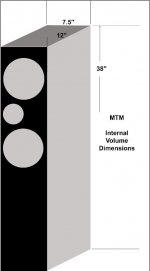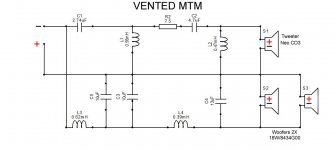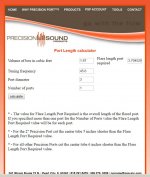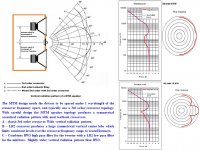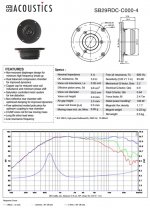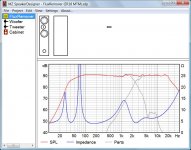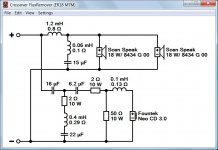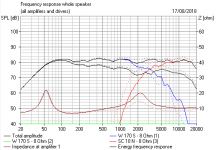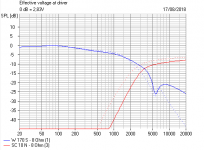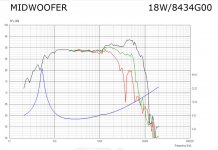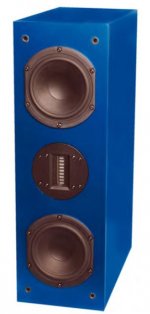I purchased a couple Fountek NeoCD3.0 tweeters and four Scanspeak 18W/8434G00 drivers.
I compiled a crossover schematic using XSim software but it is the first time I have used this software and I am wondering if my design is off the mark. I have purchased the drivers and I am committed to a vented Baltic birch enclosure with a 3 inch port(tapered on one end exiting the cabinet). I am not using DSP technology and I am not bi-amping, though the later is an option.
I feel confident the design will work, but I am concerned about the crossover and wondering if I should make some changes? I am looking for advice.
I compiled a crossover schematic using XSim software but it is the first time I have used this software and I am wondering if my design is off the mark. I have purchased the drivers and I am committed to a vented Baltic birch enclosure with a 3 inch port(tapered on one end exiting the cabinet). I am not using DSP technology and I am not bi-amping, though the later is an option.
I feel confident the design will work, but I am concerned about the crossover and wondering if I should make some changes? I am looking for advice.
Attachments
Last edited:
There is software to simulate baffle effects and it appears that you may have forgotten about it. And one more small detail, you have confused Bagby with XSim.
I do not know how to compensate the effects of the baffle with dual drivers. I need help with that one. Sorry to Xsim creator(s) for the Bagby error.
Traced frd of a woofer appears 2 dB lower than the one in pdf
I had some difficulty getting the frd and zma for the woofer so I contacted Scanspeak directly. They sent me a spreadsheet with the information. I will double check the woofer traces for accuracy.
Lately people use VituixCad as an all in one solution.
Wow! That looks interesting. I will check it out ASAP.
Thank you for taking the time to help me out.
BTW, nice world cup!
Last edited:
This might be tricky case due to excessive directivity of mid-woofers just below XO, and incompatibility with small ribbon which should be crossed quite high to avoid distortion and compression issues.
Quick'n'dirty XO simulation without reflex simulation at low freq, but simulated baffle step is included. Curves are traced from datasheets and directivity simulated with Diffraction tool.
Quick'n'dirty XO simulation without reflex simulation at low freq, but simulated baffle step is included. Curves are traced from datasheets and directivity simulated with Diffraction tool.
An externally hosted image should be here but it was not working when we last tested it.
This might be tricky case due to excessive directivity of mid-woofers just below XO, and incompatibility with small ribbon which should be crossed quite high to avoid distortion and compression issues.
I can not argue. I think it might be best for me to add a small midrange driver and pick new crossover points. Like a Dayton RS52-8FN then cross it at 800Hz and 3.8KHz? I don't know. I really want to get it done and over...
Perhaps a version of the 'Mini Statements' is in order? Salvage the parts I have?
Attachments
Last edited:
I think it might be best for me to add a small midrange driver and pick new crossover points. Like a Dayton RS52-8FN then cross it at 800Hz and 3.8KHz?
At least sound is easy to get healthy with small 4-4.5" mid. In addtion, basic 3-way is easy design properly(*) compared to 2-way - especially MTM 2-way if directivity features of M and T are from different planets, and T is small (real) ribbon which is weak performer below 4 kHz. Somehow MTMs seem to be quite popular here
(*) By axial response only is not properly designed.
3-way with small mid (<5") does not have so much nuance resolution in sweet spot, and sound stage might be difficult to get stable and logical with variable toe-in/out. Edge rounding >=35 mm helps a lot. But the sound is healthy and balanced from mid to top octave no matter where you listen.
I think it might be best for me to add a small midrange driver and pick new crossover points.
Consider:
-Purchase a robust 1" dome tweeter like the $53 SB29RDC-4 for your MTM with 18cm midrange;
-Use your ribbon tweeter in a future 3-way design with one 4" midrange which has the polar response and speed for the marriage.
==========
An MTM topology with 18cm midranges and a 1" dome tweeter like the $53 SB29RDC-4 which can handle 1.5-1.6Khz BW3/BW3 crossover circuits will generate a wide vertical radiation pattern, which interacts with a small/modest size room for a big symphony sound.
The same drivers with LR2/LR2 crossover circuits will generate a powerful narrow centered lobe vertical radiation pattern, with reduced room interaction. Seated HT listeners might favor this in a modest size room.
The same drivers with a BW3 circuit on the tweeter and LR2 circuit on the midranges will have enough crossover phase shift difference to fake improved T-M time alignment on a flat baffle, and generate a wide vertical radiation pattern, which interacts with the room for a (slightly more coherent) big symphony sound.
Attachments
Another view into MTM with BW3/BW3.
It will not resolve all problems of MTM (as simplified theoretical format) but produces different kind of unbalanced sound (which could be suitable for some room and listening setup). In practice we have some possibilities to create quite straight power response tilt. Better that simplified theory shows.
An externally hosted image should be here but it was not working when we last tested it.
An externally hosted image should be here but it was not working when we last tested it.
It will not resolve all problems of MTM (as simplified theoretical format) but produces different kind of unbalanced sound (which could be suitable for some room and listening setup). In practice we have some possibilities to create quite straight power response tilt. Better that simplified theory shows.
I really want to get it done and over...
Perhaps a version of the 'Mini Statements' is in order? Salvage the parts I have?
Then the best option is to build the ER18 MTM designed by Dennis Murphy and Paul Kittinger: New DIY MTM Towers designed by Dennis Murphy and Paul Kittinger | Audioholics Home Theater Forums
pdf writeup: https://forums.audioholics.com/forums/attachments/er-mtm-ribbon-or-dome-tweeter-pdf.23036/
Use a 20 AWG woofer coil of 1.2 mH for the Scanspeak drivers. Then the result is very close to the original design.
Attachments
Then the best option is to build the ER18 MTM
The cat is out of the bag!
This IS the design I started to pursue from the beginning but like kimmosto, I too noticed the tweeter getting driven way beyond its ability in the crossover you provided.
I raised the series 2 ohm 10 watt resistor on the tweeter to 5.6 ohms to lower the power delivery to the transducer. Then take a look at the power dissipation of the components servicing the tweeter and you will see a complete disaster of nightmares.
I am sorry but the crossover in the design documented by Dennis Murphy and Paul Kittinger is a complete joke.
This is the story how I got into this situation a year ago. Now I have these nice components collecting dust.
I think I will get on with my life and build my box with the kimmosto crossover from post #7. I think it is a fun option to go with. But then again LineSource has presented another option with the SB29RDC-4. That just breaks my heart to build a box without my Neo tweeters. I have been wanting to build a great design with that ribbon tweeter for a long time. The situation with Murphy and Kittinger just puts me out of shape.
Everything you read on the internet is not true...
I really appreciate the input from ALL of you here.
Last edited:
Hi Flux, it looks as if you had made a wrong assumption by thinking that a total power output provided by your amp will be equal as much with bass frequencies as with high frequencies which made you believe not favorably of the crossover filter. You will find no other special power rating of the components in a similar commercial product. The SQ of the project design is entirely defined by the FR performance of the loudspeaker. This is the main concern for it defines how it sounds.
Last edited:
I often end up arguing with eriksquires about 6" scanspeak drivers. I usually say it is the speaker from hell, and he says his 4 ohm scan driver works well. 
Ah well, maybe he has had a very good idea here, and it IS all about ideas in the end:
SNR-1 : Mundorf / Scanspeak 2 Way
What he has done that is extremely clever is get a higher crossover than second order designs tend to. And this must help. I really didn't find the frequency response was bad at all in my sim with own preferred drivers.
Dotted is the usual second order solution. The solid line is my implementation of first order bass. It gives the tweeter a much easier ride. Phase, BTW, is exemplary on alignment.
Ah well, maybe he has had a very good idea here, and it IS all about ideas in the end:
SNR-1 : Mundorf / Scanspeak 2 Way
What he has done that is extremely clever is get a higher crossover than second order designs tend to. And this must help. I really didn't find the frequency response was bad at all in my sim with own preferred drivers.
Dotted is the usual second order solution. The solid line is my implementation of first order bass. It gives the tweeter a much easier ride. Phase, BTW, is exemplary on alignment.
Attachments
The SPL response from the 7" 18W/8434G00 craps out above 1.1kHz.
Simulations suggest that that you could get a better sounding MTM speaker with a better polar response pattern if you purchased the 1.1" SB29RDC-4 dome tweeters and designed a good 1,500Hz crossover using BW3 circuit on the tweeter and BW3 circuit on the parallel 18W midranges.
Study the Murphy/Kittinger audioholics thread and decide you will live with the sound problems and hi-SPL ribbon damage risk described and measured.
OR, purchase 1.1" SB29RDC-4 tweets
It would take about 1 hour with Vituix to sim:
-classic BW3 tweeter circuit + BW3 parallel midranges circuit
-BW3 tweeter circut + LR2 midranges circuit to test if the phase difference improves the flat baffle physical offset effects, or if too much 18W cone crap above 1.1kHz comes through.
=======OR
If you LOVE LOVE
LOVE LOVE
LOVE the Fountek ribbon,
the Fountek ribbon,
you should purchase a 4" midrange which can smoothly crossover at 2.5-3kHz and build a 3-way T-M - WW, which will produce a more detailed soundstage than the 7" MTM. I think this is your best path to great sound. Look at the 90db sensitivity SB15MFC30-4.
Simulations suggest that that you could get a better sounding MTM speaker with a better polar response pattern if you purchased the 1.1" SB29RDC-4 dome tweeters and designed a good 1,500Hz crossover using BW3 circuit on the tweeter and BW3 circuit on the parallel 18W midranges.
Study the Murphy/Kittinger audioholics thread and decide you will live with the sound problems and hi-SPL ribbon damage risk described and measured.
OR, purchase 1.1" SB29RDC-4 tweets
It would take about 1 hour with Vituix to sim:
-classic BW3 tweeter circuit + BW3 parallel midranges circuit
-BW3 tweeter circut + LR2 midranges circuit to test if the phase difference improves the flat baffle physical offset effects, or if too much 18W cone crap above 1.1kHz comes through.
=======OR
If you LOVE
 LOVE
LOVE LOVE
LOVE the Fountek ribbon,
the Fountek ribbon,you should purchase a 4" midrange which can smoothly crossover at 2.5-3kHz and build a 3-way T-M - WW, which will produce a more detailed soundstage than the 7" MTM. I think this is your best path to great sound. Look at the 90db sensitivity SB15MFC30-4.
Attachments
Last edited:
If you LOVE the Fountek ribbon, you should purchase a 4" midrange which can smoothly crossover at 2.5-3kHz and build a 3-way T-M - WW, which will produce a more detailed soundstage than the 7" MTM. I think this is your best path to great sound.
In my heart I know this is what I should do. I kind of realized this many months ago. It is sinking in deeper now that I am back on this project again. I have to buckle down and grind it out again. I will make an attempt to find a midrange driver under $100 ea and try to get the TM WW thing going. I wonder if I can do it in the box shape from post #1?
Thanks again to each of you to share your views and experience.
The whole thing would be dead easy with 5" basses and a higher crossover. And there are loads to choose from. These are peerless by the look of them.
Fountek NeoCD3.0 Ribbon tweeter
You end up with the classic MTM ribbon design I much admire. Doing it BW3 might be possible. It's been done before in the BBC LS3/5A.
I always think two 4 ohm basses wired in series makes more sense for nice impedance.
I really don't know if eriksquires' design translates well to MTM with those scan 6" of yours. You'd have to model it.
Fountek NeoCD3.0 Ribbon tweeter
You end up with the classic MTM ribbon design I much admire. Doing it BW3 might be possible. It's been done before in the BBC LS3/5A.
I always think two 4 ohm basses wired in series makes more sense for nice impedance.
I really don't know if eriksquires' design translates well to MTM with those scan 6" of yours. You'd have to model it.
Attachments
- Status
- This old topic is closed. If you want to reopen this topic, contact a moderator using the "Report Post" button.
- Home
- Loudspeakers
- Multi-Way
- MTM crossover concerns HELP required
